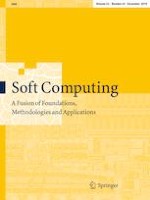20.03.2019 | Methodologies and Application
Unsupervised software defect prediction using signed Laplacian-based spectral classifier
Erschienen in: Soft Computing | Ausgabe 24/2019
EinloggenAktivieren Sie unsere intelligente Suche, um passende Fachinhalte oder Patente zu finden.
Wählen Sie Textabschnitte aus um mit Künstlicher Intelligenz passenden Patente zu finden. powered by
Markieren Sie Textabschnitte, um KI-gestützt weitere passende Inhalte zu finden. powered by
